#rabadies
Explore tagged Tumblr posts
Text
Fifth part of the bookscans of Al Andalus. Historical Figures, here's the previous part
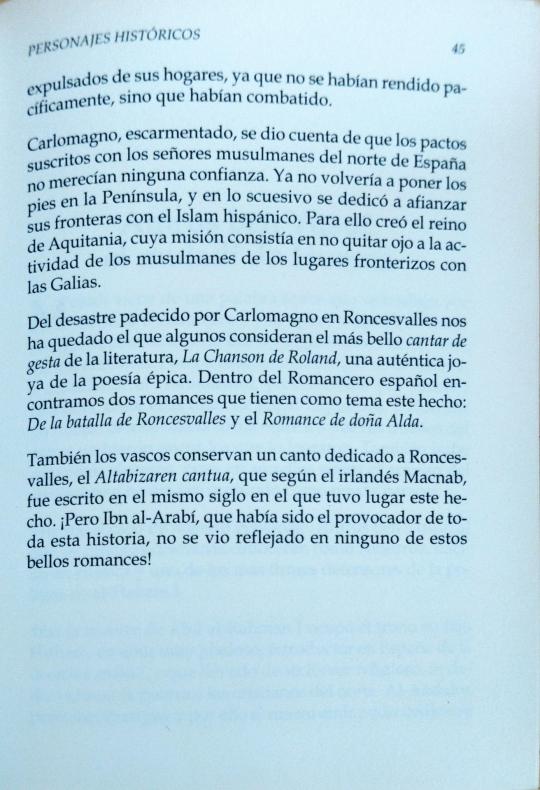
expelled from their homes, since they had not surrendered peacefully, but had fought.
Charlemagne, chastened, realized that the pacts signed with the Muslim lords of northern Spain deserved no trust. He would never set foot on the Peninsula again, and subsequently dedicated itself to strengthening its borders with Hispanic Islam. For this he created the kingdom of Aquitaine, whose mission consisted of not taking our eyes off the activity of the Muslims of the places bordering Gaul.
From the disaster suffered by Charlemagne in Roncesvalles we have remains what some consider the most beautiful song of deeds of literature, La Chanson de Roland, an authentic gem of the epic poetry. Within the Spanish Ballads we find two romances that have this fact as their theme: Of the battle of Roncesvalles and the Romance of Doña Alda. The Basques also preserve a song dedicated to Roncesvalles, the Altabizaren cantua, which according to the Irishman Macnab, was written in the same century in which this event took place. But Ibn al-Arabí, who had been the originator of this whole story, was not reflected in any of these beautiful romances!

Amrus ben Yusuf: the muladí of Huesca
Muladí comes from an Arabic word that translates as "mixed race or foreigner", and was applied to those Christians who converted to Islam and continued living among the Muslims. There were many who decided to abandon Christianity, possibly for practical reasons, including stopping paying taxes, or reaching a position of social relevance among the new owners of the country and there were not a few who achieved it. There was also sincere converts, since in those centuries the roots of the Christianity was not as deep as it may seem.
This was the case of our character, Amrus ben Yusuf, whom the Christian chronicles will know him as Amorroz, born in Huesca and one of the staunchest defenders of the policies of al-Hakam I. After the death of Abd al-Rahman I, his son Hisham, a very pious emir, introducer of the Maliki doctrine in Spain, and who Driven by his religious fervor, he dedicated himself to waging war on the Northern Christians. Al-Andalus remained at peace and therefore the new emir was able to dedicate himself

to harass the Asturian monarchy. But his reign was to be very short, just seven years, and was succeeded by his second son, al-Hakam I.
But the arrival of the new emir was greeted with rebellions in all the border marches. In the most remote areas of Córdoba, the authority of the emir hardly represented anything and the governors lived in a regime of almost total independence. The insurrections against the power of the emirate were more than frequent and al-Hakam had the unfortunate luck to have to face them all. In this hard task, he will have a paladin who will always be at his side: Amrus, who will not hesitate to take radical measures when the matter is serious. This muladí would become famous on what was known as the “day of the pit.”
In the year 797, the always restless Toledo, inhabited mostly by muladíes, rose up against the Umayyad power to recognize a rebel Ubayd Allah ben Jamir, who together with a poet of Toledo, Girbib ben Abd Allah, dissatisfied with the emir, had in charge of calming down the spirits. It wasn't the first time this happen, nor would it be the last, and al-Hakam's predecessors had already had to work hard to put a stop to the rebels of Toledo.
Amrus, who at that time ruled the stronghold of Huesca, was commissioned by the emir to subdue that uprising by the means that it considers opportune. And there went Amrus willing not to disappoint his lord.

He began by eliminating the leader of the rebellion, Ubayd Allah ben Jamir, who fell into a trap prepared by him and then decided to give a lesson to the people of Toledo that they would find difficult to forget.
Amrus, according to him to avoid friction with the population, said that the best would be that, along with his troops, he would settle on a mound near the city. Towards the northwest, near the bridge over the Tagus River, rose a small fortress, possibly on the site now occupied by the Alcazar. When the enclosure was more or less finished, the emir, in agreement with Amrus, he sent an army under the command of his son, the prince Abd al-Rahman, pretending that he was going on an expedition against the Christians and that "coincidentally" had to pass near Toledo. It was a good occasion to invite the prince to visit Toledo, and Amrus, accompanied by the most important people of the city, they came out to receive him and begged him to honor them with his presence.
Abd al-Rahman seemed somewhat reluctant to accept the invitation, but In the end he agreed to it and to celebrate it the most influential mula-díes of Toledo were invited to the new fortress to celebrate a banquet in honor of the emir's son. Until then everything was more or less normal, but as the guests arrived, they became enter through a narrow passage, at the very edge of a large ditch, and the Amrus's executioners cut off their heads, while their bodies was thrown into the pit. That was the " castle of you will go and no you will come back"!
The number of those beheaded was very large. Maybe not as much as 5,000, according to some chroniclers; maybe about 700
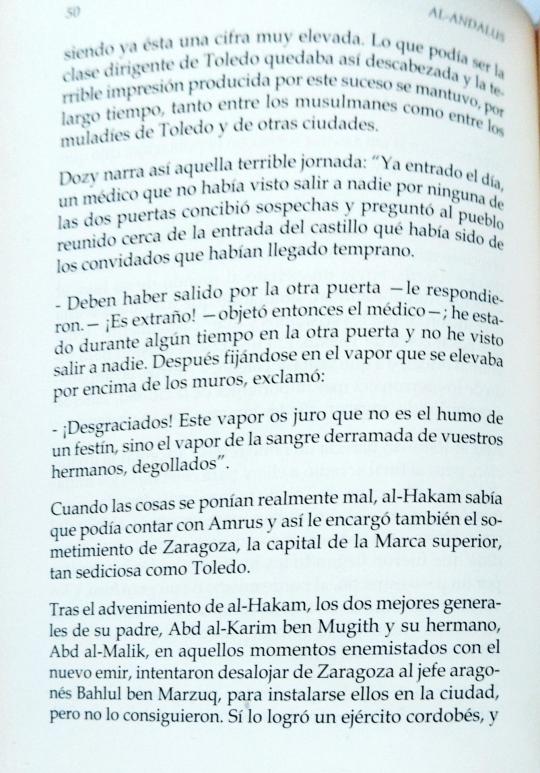
being a very high number. What the leading class of Toledo was thus beheaded and the terrible impression produced by this event remained, for a long time, both among the Muslims and among the muladies of Toledo and from other cities.
Dozy narrates that terrible day like this: "At daybreak, a doctor that had not seen anyone leave through either of the two door, became suspicious and asked the people gathered near the entrance of the castle what had happened to the guests who had arrived early. "They must have gone out through the other door," they answered- It's strange!-the doctor then objected -; I have been for some time at the other door and I haven't seen anyone leave. After watching the steam rising above the walls, exclaimed:
Unfortunates! I swear to you that this vapor is not the smoke of a feast, but the vapor of the shed blood of your brothers, beheaded"
When things got really bad, al-Hakam knew that he could count on Amrus and so he also entrusted him with the submission of Zaragoza, the capital of the Upper March, as seditious as Toledo.
After the advent of al-Hakam, the two best generals of his father, Abd al-Karim ben Mugith and his brother, Abd al-Malik, in those moments at enmity with the new emir, they tried to evict the Aragonese chief Bahlul ben Marzuq from Zaragoza, to They settled in the city, but they did not succeed. He got a Cordoban army, and
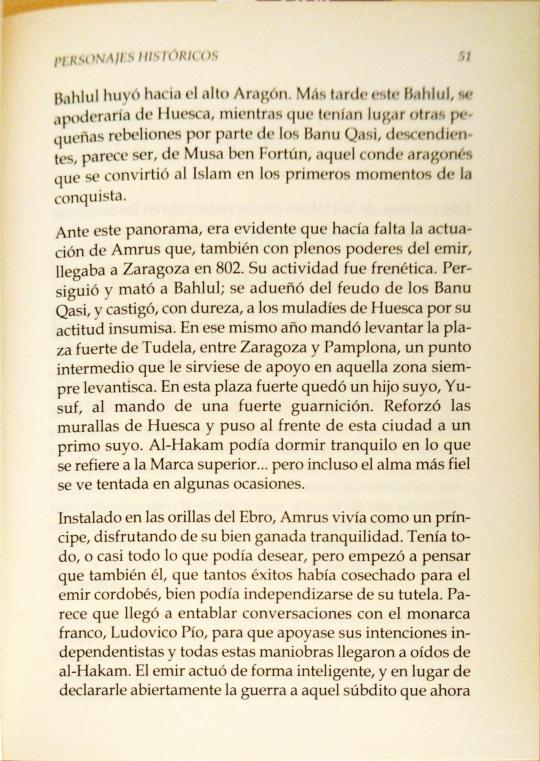
Bahlul fled towards upper Aragon. Later this Bahlul, would take over Huesca, while other small rebellions by the Banu Qasi took place, who were descendants, it seems, of Musa ben Fortún, that Aragonese count who converted to Islam in the first moments of the conquest.
Given this panorama, it was evident that the action of Amrus who, also with full powers of the emir, came to Zaragoza in 802. Its activity was frenetic. Persecuted and killed Bahlul; took over the fiefdom of the Banu Qasi, and harshly punished to the muladíes of Huesca for their rebellious attitude. In that same year he ordered the construction of the stronghold of Tudela, between Zaragoza and Pamplona, an intermediate point that would serve as support in that always upheaval area. In this stronghold there was his son, Yusuf, commanding a strong garrison. He reinforced the walls of Huesca and put one of his cousins in charge of this city. Al-Hakam could sleep peacefully when it came to the Upper March... but even the most faithful soul is tempted in some occasions.
Installed on the banks of the Ebro, Amrus lived like a prince, enjoying your well-earned peace of mind. He had everything, or almost everything he could want, but he began to think that he too, which had garnered so much success for the emir of Cordoba, could become independent of his tutelage. It seems that he came to engage conversations with the Frankish monarch, Louis the Pious, so that supported their independence intentions and all these maneuvers reached al-Hakam's ears. The emir acted intelligent, and instead of openly declaring war on that subject that now
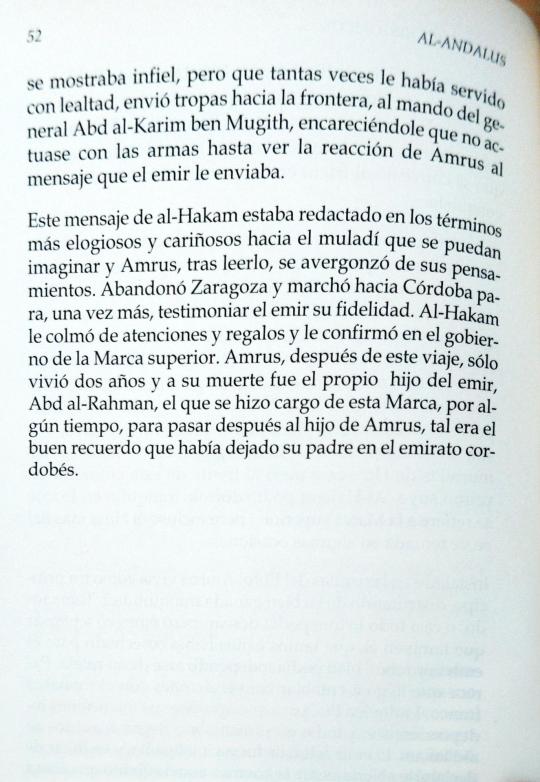
showed to be unfaithful, but that he had served him so many times with loyalty, he sent troops to the border, under the command of General Abd al-Karim ben Mugith, urging him not to act with the weapons until seeing Amrus's reaction to the message that the emir gave him.
This message from al-Hakam was written in the most praiseworthy and affectionate towards the muladí that you can imagine and Amrus, after reading it, was ashamed of his thoughts. He left Zaragoza and marched towards Córdoba to, once again, bear witness the emir his fidelity. Al-Hakam showered him with attention and gifts and confirmed him in the government of the Upper March. Amrus, after of this trip, he only lived two years and at his death the son of the emir, Abd al-Rahman, took charge of this March, for some time, to later pass to the son of Amrus, such was the good memory that his father had left in the emirate of Cordoba.

The "Rabadis": adventurous spirits
Most historians consider the emir al-Ha-kam I despotic and cruel. There is no doubt that his character was too impulsive and his justice extremely summary, but it is also true that his reign was affected by a series of rebellions and serious events that he had to repress as best he could. He never enjoyed the appreciation of his subjects who considered him inflexible, little inclined to piety, although it was not like that, abusive with taxes and little given to listening advice from no one. However, Dozy believes that he also had humanitarian feelings, like any other man, and that, despite of his cruel actions, his bad reputation was due, especially, to the wrath of the rebellious alfaquis, whom this emir never appreciated. And in this context, the terrible events of the suburb, rabad in Arabic, took place.
The emiral city of Córdoba had grown a lot. From Africa and from the East any Arabs and Berbers from the Maghreb continually arrived attracted by the prosperity of al-Andalus. The mosque had to be expanded larger to accommodate the number of believers who came to pray to it, and

The city was expanding beyond its walls. After the Roman bridge over the Guadalquivir was restored, there was no longer a problem for the population to settle in a suburb on the left bank of the river, which reached the vicinity from a village, Shaqunda, ancient Roman Secunda.
The inhabitants of this suburb were of very diverse origins and they carried out a multitude of diverse jobs. Besides of what could be considered the Cordoba plebs, there were many small Mullawad and Christian artisans and merchants, but due to its proximity to the main mosque and the emiral palace, many Cordobans who were employed, either in the mosque or in the palace, they settled there. Among this diverse population, also found the alfaquíes, religious leaders of the doctrine Malikí, who had reached a very prominent position and a very notable influence at court, especially with the emir Hisham, father of al-Hakam I.
This suburb will soon become a focus of discontent towards the emir's policy, promoted by the same alfaquies who with al-Hakam had neither the appreciation nor the influence that they achieved with his predecessor. On the other hand, in the city al-Hakam did not enjoy of many sympathies so it was only a matter of time before the situation exploded.
And it happened that one day a rumor spread through the city that seventy-two leading citizens had been executed and that their corpses were going to be exposed, crucified, on the right bank of the Guadalquivir. The mood be-
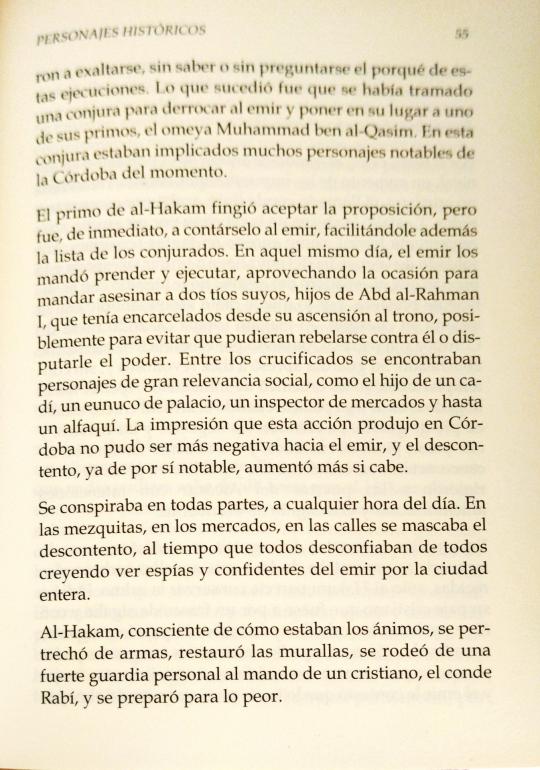
gan to exalt, without knowing or without asking themselves the reason for these executions. What happened was that a plot had been hatched to overthrow the emir and put in his place one of his cousins, the Umayyad Muhammad ben al-Qasim. Many notable people from the Córdoba of that time were involved in this conspiracy. Al-Hakam's cousin pretended to accept the proposal, but was immediately to tell the emir, also providing him with the list of the conspirators. Inthat same day, the emir ordered them to be arrested and executed, taking advantage of the occasion to order the murder of two of his uncles, sons of Abd al-Rahman I, who had been imprisoned since his ascension to the throne, possibly to prevent them from rebelling against him or challenging him for power. Between the crucified were figures of great social relevance, such as the son of a cadi, a palace eunuch, a market inspector and even a alfaqui. The impression that this action produced in Córdoba could not be more negative towards the emir, and the discontent, already notable, increased.
There was a plotting everywhere, at any time of the day. In the mosques, in the markets, in the streets discontent was chewed, while everyone distrusted everyone, believing they saw spies and confidants of the emir throughout the entire city.
Al-Hakam, aware of the mood, equipped himself withweapons, restored the walls, surrounded himself with a strong personal guard under the command of a Christian, Count Rabí, and prepared himself for the worst.
#book scans#al andalus. historical figures#al andalus. personajes históricos#al andalus#al andalus history#bookblr#historyblr#spanish history#sulayman ibn yaqzan ibn al-arabi#amrus ibn yusuf#rabadies#rabadi#al hakam i#al hakam i of córdoba#emirate of cordoba#umayyad emirate of córdoba#middle ages#rabadid dinasty#hisham i#hisham i of cordoba
10 notes
·
View notes
Text
Secret Comics’ “Creepsters 2” Now on Indiegogo, Kickstarter
Secret Comics’ “Creepsters 2” Now on Indiegogo, Kickstarter | #Comics #Horror #Indiecomics #FestivalOfDread #SciFi

View On WordPress
0 notes
Quote
Then I took a breath and put aside both my dismay and ego. While they were potentially useful in the short term—helping me to push ahead—both were ultimately flawed strategies; they put too much power into the hands of others by letting them control me through their criticisms, complaints, and even their flattery. It was better to do what I wanted, to follow my heart for my own reasons.
Samer Rabadi, The Way of the Hunter (Eight #2)
0 notes
Text













Post 0681
I pride myself on finding the good in people -- however I have almost had to question my humanity because I struggle to find any humanity with this defendant. -- Judge
Jacob Klein, New York inmate 23B5392, born 1981, incarceration intake December 2023 at age 42, sentenced to life, with parole eligibility in April 2047
Murder
Jacob Klein, who was found guilty of second-degree murder and was sentenced to 25 years to life in prison in December 2023. Klein represented himself in court, defending himself from accusations that he killed Philip Rabadi in April 2022, just months after Rabadi married Klein’s former girlfriend, Elana Radin.
During court, four victim statements were given from Radabi’s mother, father, brother, and sister. Over a dozen members of Rabadi’s family were in the courtroom. Jessica Blain-Lewis, Assistant District Attorney and prosecutor for this case, read a statement on behalf of Radin, who was not present in court.
Klein did not offer an apology, but made a brief statement to Rabadi’s family and the courtroom. Judge Little addressed Klein personally. “People who know me know I pride myself on finding the good in people even in their darkest moment,” Little said. “I’ve almost had to question my humanity over the last couple days because I struggle to find any humanity in Mr. Klein.”
Prosecutors said they believe the only reason Klein chose to represent himself was to force Radin to face him directly. Klein’s side counsel did not disclose why Klein chose to represent himself.
4j
Last Reviewed March 2025
143 notes
·
View notes
Text
SWEENEY TODD - BROADWAY - JANUARY 2024

Sweeney Todd | Broadway (3rd Revival) | 2024, January | MP4 (12.25 GB, 2160p) | The Riddle’s master Cast: Josh Groban (Sweeney Todd), Annaleigh Ashford (Mrs. Lovett), Daniel Yearwood (Anthony Hope), Maria Bilbao (Johanna), Jamie Jackson (Judge Turpin), Daniel Marconi (Tobias Ragg), John Rapson (Beadle Bamford), Ruthie Ann Miles (Beggar Woman), Nicholas Christopher (Adolfo Pirelli), Stephen Tewksbury (Jonas Fogg), Jonathan Christopher (Bird Seller), Taelar Cyrus (Ensemble), Timothy Hughes (Ensemble), Paul-Jordan Jansen (Ensemble), Alicia Kaori (Ensemble), Raymond J. Lee (Ensemble), Mia Pinero (s/w Ensemble), Lexi Rabadi (Ensemble), Nathan Salstone (Ensemble), Kristie Dale Sanders (Ensemble), Stephen Tewksbury (Ensemble), Daniel Torres (Ensemble), Felix Torrez-Ponce (Ensemble), DeLaney Westfall (Ensemble)

Notes: Excellent 4k capture of Josh and Annaleigh’s last show with the company. One long blackout during the Ballad of Sweeney Todd due to usher activity (unfortunately, there is no video of Josh's entrance), and the beginning of “God, That’s Good!” is audio only due to latecomers/usher activity. A few other occasional blackouts due to usher activity. Video takes a while to get settled in act one, but once it does, action is followed well with a mix of mediums, wides, and zooms. Minor obstruction from a railing and heads from time to time. Includes Josh and Annaleigh’s goodbye speeches.

NFT DATE: AUGUST 1, 2024 Sales only until NFT date; price is $18
email theriddletrades@gmail.com if interested Screenshots: https://flic.kr/s/aHBqjBbC85
57 notes
·
View notes
Text
Last Song I Listened To:
"You" by Tennyson! it's a sweet little song and i use it for my qpr-in-my-series playlist. "What's the point of that? I could be pressing flowers with you. Savor all this time rather than fret all afternoon. Take me from my thoughts, now would be riper than limes in June." so soft.
Last Book I Read:
The Ballad of Black Tom by Victor LaValle is the last book i finished. phenomenal book. absolutely wonderful on a craft level. It pushes the reader to question the role of a black main character in an american horror, pushes the reader to question what constitutes horror is for black americans, and in that push answers your question for you, delicately, carefully. Deserves all the praise it got. Recontextualizes one of the most racist lovecraft stories and shows the character of Black Tom's humanity even as Black Tom tries to leave humanity behind. also. sentence level? so fucking good. down to the sentence it's so good.
I'm currently in the middle of like 15 books but off the top of my head
Witch King by Martha Wells
Dreadgod by Will Wight
To Say Nothing of the Dog by Connie Willis
On the Shoulders of Titans by Andrew Rowe
The Future Is Disabled by Leah Lakshmi Piepzna-Samarasinha which feels more like a manifesto than anything else so im not really getting as much out of it bc disabled people on tumblr have been talking about the contents of this manifesto since 2015 or earlier
The League of Gentlewomen Witches by India Holton
The Last Sun by K.D. Edwards
Paul Takes the Form of a Mortal Girl by Andrea Lawlor
Way of the Hunter by Samer Rabadi
Female Masculinity by Jack Halberstam
Coming up, I'm doing a buddy read soon of The Black Shoals: Offshore Formations of Black and Native Studies by Tiffany Lethabo King with @markeyverse and a buddy read of The Cooking Gene: A Journey of African American Culinary History in the Old South by Michael W. Twitty with @toopunkrockforshul and a book club read of When the Angels Left the Old Country by Sacha Lamb
Last Thing I Watched:
Star Trek: The Next Generation. I simply don't Watch things these days, unless we count youtube, in which I have watched Drawfee's "Driving from Washington to Mexico for Charity" to cope with grief bc omg you do not need your brain for that. it's comforting. and also my roommate is obsessed with Azerbaijani Village Cooking Videos and points out different foods and how like the ones he grew up with they are and how they differ from Georgian and Russian preparation and consumption and he tells me the names of the food and what they taste like. so we watch that almost every night if i dont fall asleep first.
Current Obsession:
my own work tbh. my poetry, my fiction, my paintings. trying to get better. i suppose outside of that. hm. my interest is turning toward gay nuns as of yesterday with a Realization of christian religious trauma being more real than i thought. im looking at "Immodest Acts", "Lesbian Nuns: Breaking Silence", "Scorched Grace: A Sister Holiday Mystery", and im hoping "Sisters of Sorrow" is gay bc if its not what the fuck are you doing. but i cant delve into them all yet nor buy them yet. and im trying to prioritize my TBR.
i'm also reading eco-justice poetry/nonfiction, afrofuturist, transformative justice, disabled, and solarpunk literature for my solarpunk wip
Tags 8 people:
im tagging yall. no big if you dont wanna do the meme. im gonna go lay down now. sleepy.
@filthburgur @cadencekismet @mysanaf @vorellaraek @markeyverse @pacifistrun @outside-your-window @cassandors
7 notes
·
View notes
Text

Remembering Hindi cinema's favourite aunty, #Shammi, on her 6th death anniversary (06/03/18).
Shammi was a popular actress for funny roles in movies from 1949 to 1969 and then from 1980 to 2002. She played important side roles in well-known movies like "Dil Apna Aur Preet Parai," "Half Ticket," "Halaku," "Samaj Ko Badal Dalo," "Khuda Gawah," "Coolie No. 1," "Gopi Kishan," and "Hum Saath Saath Hain." She also acted in movies with Rajesh Khanna such as "The Train," "Aanchal," "Kudrat," "Red Rose," "Awara Baap," and "Swarg." From 1949 to 1955, she was the main actress or the second main actress in some Hindi films. Later, from 1986 to 1998, she was in famous TV shows like "Dekh Bhai Dekh," "Zabaan Sambhal Ke," "Shriman Shrimati," "Kabhi Yeh Kabhi Woh," and "Filmi Chakkar." Shammi is also the younger sister of the fashion designer Mani Rabadi.
L to R- #AshaParekh, Shammi, #WaheedaRehman, and #Helen.
4 notes
·
View notes
Link
#AaronTveit#AnnaleighAshford#Broadway#JoshGrobin#LuntFontanneTheater#NewYorkTheater#SuttonFoster#SweeneyTodd#TulisMcCall
2 notes
·
View notes
Text
[ad_1] Universal Sompo announced its collaboration with Child Rights and You (CRY) to foster educational opportunities for children in marginalized communities in Andhra Pradesh. The partnership comes on the eve of inauguration of Universal Sompo’s new corporate office in Mumbai. The initiative aims to address barriers to education and equip students with the tools needed to pursue professional courses and brighter futures. This program will directly benefit 114 students and 82 families, empowering communities by facilitating access to professional courses and better career opportunities. Universal Sompo General Insurance partnered with CRY for Educating the Marginalized Communities of Andhra Pradesh The collaboration will initiate an educational project aimed at establishing Remedial Tuition Centres specifically for 10th and 12th-grade students. The project aims to prepare students for their board examinations over a three-month period (Jan to March 2025), ensuring that all enrolled 10th and 12th graders successfully appear for these critical assessments. The initiative seeks to improve learning outcomes, particularly in challenging subjects like Mathematics and Science, guide students toward professional and science-based education streams. Additionally, the initiative includes career counselling to assist students in making informed decisions about pursuing science and mathematics streams in intermediate education, as well as engineering or medical courses in tertiary education. Sharad Mathur, MD & CEO, Universal Sompo, remarked, "Our collaboration with CRY represents our commitment to empowering communities and fostering sustainable development. Education is the cornerstone of progress, and through this initiative we aim to help children achieve academic excellence and unlock their potential for a brighter future. As the appointed insurer for the state of Andhra Pradesh, Universal Sompo continues to contribute to regional development, aligning its efforts with its mission to create meaningful social impact.” Kreeanne Rabadi, Regional Director, CRY – West states, “We are honoured to be associated with Universal Sompo in our mission to empower children through education. For four decades now, CRY has been instrumental in changing lives of lakhs of children across the country. We hope this collaboration empowers more young children in a positive way.” About Universal Sompo General Insurance Universal Sompo is a JV of Indian Bank, Indian Overseas Bank, Karnataka Bank, Dabur Investments, and a global insurer, SOMPO. The company is headquartered in Mumbai and has 185 offices countrywide with representation through its digitally enabled employees across over 300 locations. It has a strong distribution network of Agents, Point of Salespersons, Bank Branches, Automobile Dealers, Brokers, Common Service Centres, and Digital Platforms/ e-Commerce players. The company offers 234 IRDAI-approved products, and 1494 Add-on covers, ranging from Motor, Accident & Health, Home for Individuals, Shopkeepers Packages, Crop and other non-life packages for SMEs, Fire, Marine, Engineering, Employee Benefits, Project Insurance, Liability, and other special products for Corporates. Microinsurance covers the Rural segment. For more information, please visit us at www.universalsompo.com About CRY CRY - Child Rights and You is an Indian NGO that believes in every child’s right to a childhood - to live, learn, grow and play. For over 4 decades, CRY and its 850 initiatives have worked with parents and communities to ensure Lasting Change in the lives of more than 3,000,000 underprivileged children, across 20 states in India. For more information, please visit us at www.cry.org. !function(f,b,e,v,n,t,s) if(f.fbq)return;n=f.fbq=function()n.callMethod? n.callMethod.apply(n,arguments):n.queue.push(arguments); if(!f._fbq)f._fbq=n;n.push=n;n.loaded=!0;n.version='2.0'; n.queue=[];t=b.createElement(e);t.async=!0;
t.src=v;s=b.getElementsByTagName(e)[0]; s.parentNode.insertBefore(t,s)(window,document,'script', 'https://connect.facebook.net/en_US/fbevents.js'); fbq('init', '311356416665414'); fbq('track', 'PageView'); [ad_2] Source link
0 notes
Text
6th part of the bookscans of Al Andalus. Historical Figures, here's the previous part

The following year a very serious incident occurred in the suburb, and according to custom, al-Hakam acted summarily, executing all possible guilty suspects through the infamous crucifixion.
As if that were not enough, the mood of the population in general, an increase in the taxes that, on top of that, a Christian, the so-called Count Rabi, collected, ended up for exasperating everyone. And the spark of rebellion broke out over an apparently trivial matter, as happens on so many occasions. A soldier of the guard emir had his sword polished and it seemed to him that the swordsmith in the suburb did not attend to him with sufficient alacrity, so he killed him by piercing him with his sword in question. Al-Hakam was hunting outside Cordoba and upon returning, passing through the conflictive neighborhood, was booed. His guard arrested ten rioters and, without mercy, they were immediately crucified. The emir had barely arrived at his palace when the entire suburb was up in arms. Businesses were closed and the tents, and with sticks, stones, knives, and everything they had within their reach, artisans, merchants, and the general public headed to the doors of the Alcázar with threatening intentions and the design of demolishing them.
In those moments of anguish in the Alcázar, when his fate presented itself doubtful in the face of those angry mobs, only al-Hakam seemed to retain the calm. He asked his Christian page to fetch a jar of civet and with it he perfumed his hair and beard. The page asked him, astonished, how in those serious moments he could think of putting on perfume as if he were going to court a woman and the emir replied that he did it so that when the popu-

lace cut off his head to know that it was really the head of their prince and not that of any other. Measures were taken with all the speed that the committed moment required. The troops loyal to the emir ensured order in the city and the palace butler and his secretary gathered all the available forces to try to contain the rapidly advancing mobs that were leaving uniting more and more people. The emir's troops were beginning to falter in the face of what seemed an unstoppable force of the mutineers, until two of the generals from al-Hakam they managed to reach the first houses in the suburb. Then its inhabitants found themselves surrounded. The two exits of the neighborhood were taken by loyal to the emiral cause. The rout began... and the slaughter.
Al-Hakam gave orders that no mercy be shown to the rioters and for three the looting and massacre continued, and no one knows what it could had happened if the minister Ibn Mugith did not advise the emir to cease in that horrible carnage. The suburb was closed so that no one could leave there until al-Hakam passed sentence or thought about what to do with the rebel subjects. The solution was still terrible, as terrible as three hundred notables of the suburb would be crucified and the rest of the inhabitants who had survived would preserve their lives in exchange for immediately abandoning Córdoba. The suburb would be completely demolished, plowed and planted so that no one could build a house or a habitation there. None of al-Hakam's successors dared, until the end of the 10th century, to contravene that now distant prohibition dictated by the emir and the suburb remained, for

a long time, like a desolate and dead place in which it seemed impossible there would have been so much life.
The inhabitants of the suburb, "rabadis" as they would be known, had to abandon house, business and city in the first fortnight of April 818. Only the fuqahāʾ and their families were freed from this expulsion, much to the dismay of al-Hakam, knowing as he knew that if they had not been the direct instigators of the rebellion, they encouraged it and did nothing to calm things down. It is not well known how many people were banished from the suburb, it is believed that perhaps there were about 20,000, since it was a very populous neighborhood, although the figure may have been a bit exaggerated. And there begins the odyssey of the “rabadis”, who showed themselves to be accomplished adventurers, forced, no doubt, by the need.
Some went to take refuge in Toledo, a city always willing to welcome to all those who showed themselves against the central power. But they feared that the anger of that vengeful emir reached them, so they decided to flee further away, as far as to cross the sea. The Rabadis, with their families, left towards the Mediterranean coast, not without suffering the assault of the unscrupulous in their modest convoys in which they carried the few belongings they saved from the merciless looting to which they had already been subjected. Some went to North Africa and settled among the Berber tribes. In this region there were few cities and Prince Idris II was looking for inhabitants who could populate the city of Fez that their father had founded. It would not

take much time to increase this population with a new city, very close to the one that already existed and spread the word that everyone who came to populate both cities would be welcomed with open arms. Many Rabadis, with their families, moved there and very soon the new foundation of Idris II was known as Madinat al-Andalusiyyin, the “City of the Andalusians”. To this city they took the rabadis their knowledge of gardening and agriculture, crafts and architecture, as well as as their forms of citizen life. But this was not their greatest feat of those banished.
Part of them set out to sail the Mediterranean, dedicating themselves to privateering and piracy to survive. Although the Rabadis were not sailors, it is very possible that they they were accompanied by Valencian or Andalusian sailors, muladíes most likely, and that together they would undertake that adventure.
One day they docked in front of beautiful Alexandria, in those days subjected to fighting, that were taking place throughout Egypt, among the governors appointed by the caliph. The Rabadis became strong in the city and with the help of a faction Arab, the Lajmis, and the followers of a puritan Islam, created a kind of independent republic that they would maintain for more than ten years.
In vain the inhabitants of Alexandria tried, on more than one occasion, to get rid of these upstarts who had become masters of their city. Finally, in May 827, the governor Abd Allah ben Tahir, besieged them and after several days of siege, the Rabadides surrendered. They were allowed to go, but

they could not take any of their slaves and had to compromise that they would not dock in any port that was in Abbasid territory.
Thus they found themselves expelled from Egypt, as they had already been expelled from Córdoba, and they began the journey again, this time heading towards the island of Crete, which belonged to the Byzantine Empire. In command of that expedition that sought a place to settle, there was a man from Córdoba from Llano de los Pedroches, called Abu Hafs Umar al-Balluti. They landed on the island and occupied it in their whole. Abu Hafs al-Balluti founded a dynasty there that remained on the island for one hundred and thirty-four years, until the year 961.
They repelled incessant Byzantine attacks that wanted to recover Crete, until that the general Nikephoros Phocas managed to recapture the island for the Byzantine emperor Roman II.
Back at sea, those already distant Andalusians, for more than a century and medium, frightened the entire navigation of the central and eastern Mediterranean, also acting with great audacity in the Aegean islands.

Ziryab: the singer of Baghdad
A somewhat peculiar character from Muslim Spain was Ziryab, although he wasn't a politician, nor a religious person, nor a warrior, he was going to have a capital influence on the Andalusian society, creating fashions and implementing customs and ways of life that ended up adopting Moors and Christians, and that would remain until our days.
Ziryab was called that because he had very dark skin and he was given this nickname in reference to the black plumage of a bird, the blackbird, but its real name was Abu-l-Hasan Ali ben Nafi. He was born in Mesopotamia and was a freedman of the Abbasid caliph al-Mahdi. From a very young age he showed to be gifted, in a privileged way, for singing and was a disciple of another celebrity in the field of music, the singer of the Baghdad court, Ishaq al-Mawsilí. Very soon he became so famous that the Great Caliph Harun al-Rashid asked the teacher to bring his disciple to court to hear him sing.
There are many legends about this performance. One of the best known is the that Ziryab, before the caliph, very sure of himself, told him that he knew how to sing what other great singers knew but, who also sang, what no one knew sing. If the caliph so desired, he would put in his ears

a music and a song that no one had heard before. Harun al-Rashid was surprised and intrigued and wanted me to act for him, interpreting those unknown melodies.
It is said that Ziryab did not use the traditional lute as accompaniment, but who used an instrument of his invention. It was a kind of five-string guitar, the first, the third and the fifth were made with lion's guts; the second and fourth were made of red silk. To press them, instead of the typical pick of wood, he used the claw of an eagle.
Harun-al Rashid was fascinated by what he heard and told the singer that he returned the next day to perform, again, for him. But Ziryab didn't returned to the palace in Baghdad. What had happened for the musician to not coming back? Well, his master felt deep envy of the success of his disciple. He understood that he was going to take away his place as a favorite singer in the court and threatened to kill him. Ziryab, fearing for his life, decided to leave from Baghdad as soon as possible
The sad days of exile as a traveling musician began for him. For some time he lived in Cairo, crossed the deserts of Egypt and Libya and he settled in Qayrawan, a city that had nothing to do with the splendor of Baghdad or the refined Córdoba. But wherever he went, those who heard him singing could never forget the timbre of his voice and the harmony of his compositions. And so it was that through another musician, less jealous than his mas-

ter!, the Cordoban Jew Abu-l-Nasr Mansur, reached the ears of al-Hakam I the mastery of Ziryab and sent for him. Al-Hakam I, like all the emirs and, later, Andalusian caliphs, was a great lover of music and poetry and himself a notable poet. Ziryab embarked immediately to Algeciras. There, as soon as he disembarked, he received news that the emir had just died and became disheartened, thinking that his good luck was ending. But Abd al-Rahman II, son and successor of al-Hakam, let him know that he maintained the contract that his father had offered him and sent him gifts of such magnificence that the singer was clear that he would remain in al-Andalus forever. The emir received him with the greatest attention and not only that: he assigned him a fabulous pension for the time, 200 gold dinars a month, in addition to providing him with a house and servitude, giving him some land in the countryside of Córdoba, which was very productive, and complete his offering with two hundred sextars of barley and one hundred of wheat to maintain his house and his family. There was not in all Muslim world another poet, musician, singer or scholar who was better paid than Ziryab, and the splendid remunerations of which he was the object, extended, even further, his fame everywhere. In truth it must have been an exceptional being for the emir treated him with such kindness!
But to better understand the generosity of Abd al-Rahman II it is interesting to know something about what his life and his court were like, in which he adopted all the royal forms of the Court of the Abbasids. His father had left him the Treasury coffers completely packed, which allowed the new emir to dedicate

to acquire the most precious merchandise that arrived to Córdoba brought by Jewish, Slavic and Iraqi merchants.
Abd al-Rahman II was an unrepentant lover and admirer of women. Of all Europe and also from the East, beautiful young women will arrive, always virgins to the harem of the emir, who is said to have had forty-five male children and forty-two daughters. Some of his many concubines managed to reach just fame for her beauty, careful education and talent. Such is the case of the three young people known as the “Medinese”, not because they were natives of this city, what's more, one of them was Spanish, but all three had been educated in a perfect Arab culture. They were magnificent singers, versifiers and experts in Medinese music and entertained the leisure of their lord who appreciated them in such a way. So for them he had a special pavilion built inside the Alcázar.
A man like the emir, lover of all pleasures, both the sensual ones like intellectuals, it was not surprising that he appreciated moving art and only one of Ziryab, who arrived in al-Andalus in the year 822, with four children who, with over time, they would continue his work, and he stayed until his death in 857. In these thirty-five years the emir and he always maintained cordial relations and they appreciated and respected each other.
But Ziryab's activities were not only limited to music, but his genius manifested as a profound innovator of the Muslim society of the time. He created a conservatory... and a beauty institute, because Ziryab was a true and refined dandy.
#al andalus. historical figures#al andalus. personajes históricos#book scans#al andalus#historyblr#bookblr#al andalus history#spanish history#rabadies#rabadid dinasty#al hakam i#al hakam i of córdoba#emirate of cordoba#emirate of crete#abu hafs al-balluti#abd al rahman ii#abd al rahman ii of córdoba#zyriab#abu-l-hasan ali ibn nafi#zyriab the singer of baghdad#al-balluti
11 notes
·
View notes
Text
[ad_1] Universal Sompo announced its collaboration with Child Rights and You (CRY) to foster educational opportunities for children in marginalized communities in Andhra Pradesh. The partnership comes on the eve of inauguration of Universal Sompo’s new corporate office in Mumbai. The initiative aims to address barriers to education and equip students with the tools needed to pursue professional courses and brighter futures. This program will directly benefit 114 students and 82 families, empowering communities by facilitating access to professional courses and better career opportunities. Universal Sompo General Insurance partnered with CRY for Educating the Marginalized Communities of Andhra Pradesh The collaboration will initiate an educational project aimed at establishing Remedial Tuition Centres specifically for 10th and 12th-grade students. The project aims to prepare students for their board examinations over a three-month period (Jan to March 2025), ensuring that all enrolled 10th and 12th graders successfully appear for these critical assessments. The initiative seeks to improve learning outcomes, particularly in challenging subjects like Mathematics and Science, guide students toward professional and science-based education streams. Additionally, the initiative includes career counselling to assist students in making informed decisions about pursuing science and mathematics streams in intermediate education, as well as engineering or medical courses in tertiary education. Sharad Mathur, MD & CEO, Universal Sompo, remarked, "Our collaboration with CRY represents our commitment to empowering communities and fostering sustainable development. Education is the cornerstone of progress, and through this initiative we aim to help children achieve academic excellence and unlock their potential for a brighter future. As the appointed insurer for the state of Andhra Pradesh, Universal Sompo continues to contribute to regional development, aligning its efforts with its mission to create meaningful social impact.” Kreeanne Rabadi, Regional Director, CRY – West states, “We are honoured to be associated with Universal Sompo in our mission to empower children through education. For four decades now, CRY has been instrumental in changing lives of lakhs of children across the country. We hope this collaboration empowers more young children in a positive way.” About Universal Sompo General Insurance Universal Sompo is a JV of Indian Bank, Indian Overseas Bank, Karnataka Bank, Dabur Investments, and a global insurer, SOMPO. The company is headquartered in Mumbai and has 185 offices countrywide with representation through its digitally enabled employees across over 300 locations. It has a strong distribution network of Agents, Point of Salespersons, Bank Branches, Automobile Dealers, Brokers, Common Service Centres, and Digital Platforms/ e-Commerce players. The company offers 234 IRDAI-approved products, and 1494 Add-on covers, ranging from Motor, Accident & Health, Home for Individuals, Shopkeepers Packages, Crop and other non-life packages for SMEs, Fire, Marine, Engineering, Employee Benefits, Project Insurance, Liability, and other special products for Corporates. Microinsurance covers the Rural segment. For more information, please visit us at www.universalsompo.com About CRY CRY - Child Rights and You is an Indian NGO that believes in every child’s right to a childhood - to live, learn, grow and play. For over 4 decades, CRY and its 850 initiatives have worked with parents and communities to ensure Lasting Change in the lives of more than 3,000,000 underprivileged children, across 20 states in India. For more information, please visit us at www.cry.org. !function(f,b,e,v,n,t,s) if(f.fbq)return;n=f.fbq=function()n.callMethod? n.callMethod.apply(n,arguments):n.queue.push(arguments); if(!f._fbq)f._fbq=n;n.push=n;n.loaded=!0;n.version='2.0'; n.queue=[];t=b.createElement(e);t.async=!0;
t.src=v;s=b.getElementsByTagName(e)[0]; s.parentNode.insertBefore(t,s)(window,document,'script', 'https://connect.facebook.net/en_US/fbevents.js'); fbq('init', '311356416665414'); fbq('track', 'PageView'); [ad_2] Source link
0 notes
Text
0 notes
Text

Buy Paan aroma rabadi paan online in India. Each pack contains 100g of this delectable treat, perfect for satisfying your sweet cravings. Experience the authentic taste of Paan with a twist when you purchase our Rabdi Paan online in India. Enjoy the unique combination of flavors that will leave your taste buds wanting more.
#Banarasi paan franchise cost#Banarasi paan shop franchise#Paan shop franchise in pune#Best paan franchise near me#Oreo chocolate paan#Flavoured paan#Affordable paan franchise model#Low investment paan franchise model#What is the best choice as paan franchise#Silver Paan Franchise#Mix Fruit Chutney Paan#Paan business in india
0 notes
Text
Some eating rules for the festive season:
1. If you eat something, and no one saw it, it has no calories - The Penda Principle.
2. When you eat with someone else, and the other person eats more than you, your calories cancel out - The Laddoo Law.
3. If people around you have gained more weight than you have, you have automatically become thin - Burfy's Law.
4. Food with the same color have the same calories. Hence, it is okay to have pistachio ice cream instead of spinach. - The Mysorepak Mantra.
5. Calories are a measure of heat. So frozen foods like ice cream have no calories. - The Rabadi Rule.
1 note
·
View note
Text
Even today, not only us but also the stars who live a luxury lifestyle are affected by the run-of-the-mill life.
In such a situation, how many times have these cine stars gone abroad for shooting? But when it comes to private travel, they also prefer to choose a place where they can enjoy a two-minute vacation along with a relaxed atmosphere and good food. So it fills them with new energy.
Below are the favorite places of your favorite stars:-
1. Akshay Kumar, Hampi-Karnataka
Action hero Akshay Kumar loves to go to Karnataka and get refreshed. Akshay says that he did not know that there could be such a beautiful place named Hampi in Karnataka. When I went there to do a photoshoot of Rabadi Rathore, I was mesmerized by the natural environment there. I feel very comfortable going here. However, Hampi is an ancient city.
READ MORE:
0 notes
